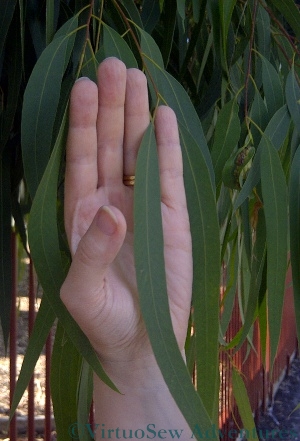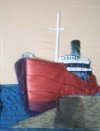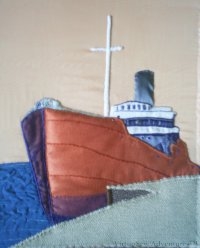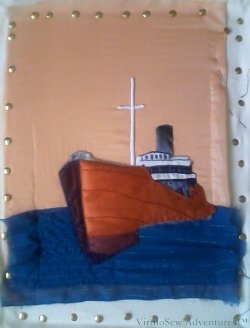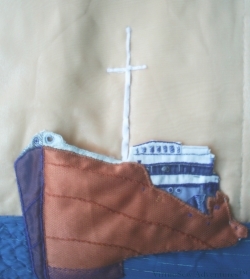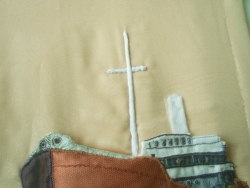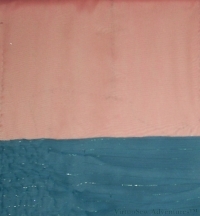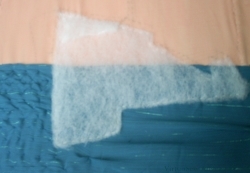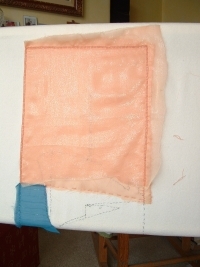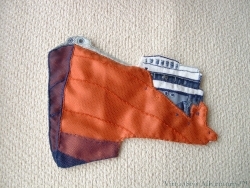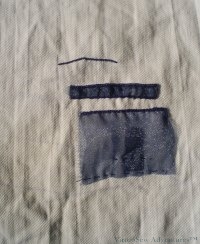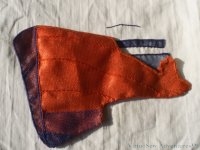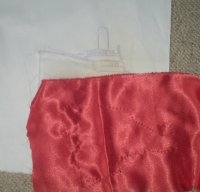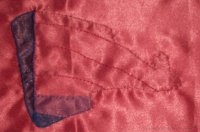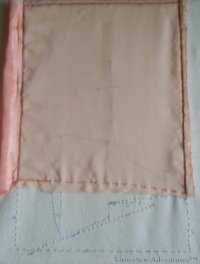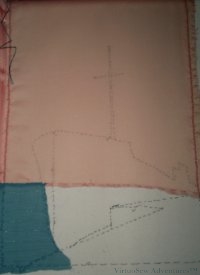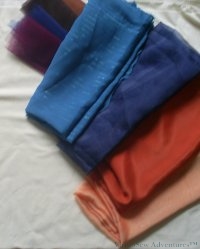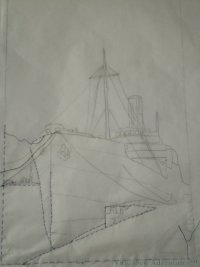Tag: applique
Australian wildlife – backgrounds
One of the hallmarks of Australian Embroidery, as shown in the magazines, is a willingness to mix techniques and “play”. So while I have no idea of how I am going to show the Rosella, I’ve been thinking in terms of creating a background of tessellated Eucalyptus leaves, one way or another. There are several ways this could be achieved, which would be to some degree in the spirit of what I have read, and I still haven’t worked out which to use. Although I hate working samples, I may have to do so this time, as I haven’t the faintest idea whether they will work!
- For example, the simplest, once I’ve developed and charted a tessellation, would be to work the background on canvas, using complete coverage. That might be a little dull..
- Another possibility would be to use a painted canvas or to overlay the canvas with gauze, and then just work the leaf shapes themselves and leave everything else un-stitched. I like that idea, but I think it will need playing with, to get the right gauge of thread to provide suitable coverage and at the same time not puncture the gauze too obviously. I won’t be able to unpick it either, so stitching it might be a nervy business!
- Then there is the possibility of using waste canvas over a felt or a linen background fabric, so I can chart the tessellation without being stuck with canvas as the whole background.
- Finally – although this is well outside my usual range of stitching – I could create cut-outs of the leaf shapes and sandwich them between layers of gauze, with minimal stitching to hold them in place.
Gosh. When I sat down to write this, the last couple of ideas hadn’t come to me at all! That’s one of the unanticipated benefits of blogging, because in sitting down to explain what I am doing, or planning, I concentrate so much more on the subject that I get even more ideas, and what’s more, I’ve got them written down, so when I actually get to that part of the project, I have my notes – often illustrated notes! – to help me reconstruct my ideas.
It would be nice to work this while I’m actually in Australia, using Australian sourced materials, so I think I need to spend more some time planning the project before our next visit.
The Camberwell Panel – Ten
I ended up using both fabrics.
I decided to use a layer of the darker fabric to create the shadow of the face of the quayside edge, covered with a layer each of brown and navy net.
The two layers of net intensified the darkness of the shadow, but at the same time, suggested the roughness of the surface. The net was cut as fragments – not the same size – and the heavy material is cut to the same basic shape as the top layer, there were no lines of fabric edges showing through.
The slip for the upper layer was outlined in buttonhole stitch and then attached over the top. At this stage I felt that some additional stitching would be be needed to create an impression of the quayside in similar detail to the ship itself but now the only fabric to be applied was the border.
Which at this point I still hadn’t yet decided on….!
The Camberwell Panel – Nine
When I began to attach the slip, I needed to make sure that the background would be smooth and straight, so as the floor frame was failing to achieve that, I transferred the work to an old set of stretcher bars and used plenty of drawing pins to attach the fabric. I wasn’t concerned about holes in the fabric because the pins were well outside the area of the design that would be on show.
This photo shows the slip of the hull and superstructure, the funnel, and the masts finally attached. Each area was firmly sewn on using a suitable colour of stranded cotton (several different colours in the the case of the hull!), and the holes for the anchor chains were held down to let the background show through.
There are some small elements which yet need to be done on the ship – notably the rigging, but the next important element is the quayside. I had originally picked out two upholstery fabrics to choose between, one of them dark and heavily patterned, and the other lighter and smoother, but as it turned out both of them came in useful….
The Camberwell Panel – Eight
While I was attaching the hull, I was also looking at my references on Stumpwork, or Raised Work. The headache that had been looming all the way through to this point was, How Shall I Do The Mast?
I tried to cover straws with thread or find narrow pieces of plastic or wood, and all of the attempts looked clunky and un-seaman-like. I thought about trying to use stitching – either satin stitch or lines of stem stitching, but in the end decided that these elements needed to be smooth and relatively featureless, whereas the stitching in the piece is entirely to create detail. When I thought a bit harder, it seemed to me that the mast and spar weren’t mere “details” and that there would be a rather jarring effect if I created them using a “detail” technique, rather as though they’d been magnified, or something like that.
In the end I decided to continue using only fabric in the piece. This meant a slightly more difficult process, as the mast and spar are narrow and need to be rounded, but it also maintains the integrity of the design as a purely fabric appliqué.
So: the mast and spar were padded with slivers of felt and covered with narrow cotton tape. This made the ends slightly tricky (the tape kept trying to fray), but provided a clean edge on either side of the spars.
I also attached the padding for the funnel to the background. Both of these needed to be attached before the entire slip for the hull and superstructure were entirely caught down, but at the same time I couldn’t be sure of the placements (wretched shrinkage!) until I had the slip in place.
The Camberwell Panel – Seven
Remember I said that the Camberwell had other ideas for the background?
At this point the deafening racket of complaints from her became too much for me to ignore and I unpicked all of the background and reinstated it, differently. For instance, you might notice that the twinkly fabric for the water is puckered and gathered to create ripples on the surface.
I then pinned on the different choices of quayside fabric I had prepared, and the slip for the hull, and contemplated them for a while. Beside helping to clear up my choice, I realised that the picture was going to work better if I brought the edges in closer to the ship rather than having an expanse of sky above the mast.
So, those choices and decisions made, I moved on. I wanted to make sure that the prow “loomed” somewhat, so I put a layer of padding in the shape of the hull over the background. That should also help to ensure that the horizon line does not show through the slip, as well as differentiating the looming bow from the bridge and superstructure. So I also added a further small extra patch of padding to emphasize the flare of the bow – you can probably just see it.
The Camberwell Panel – Six
I finally decided that I wanted to use two layers of gauze for the sky. The apricot gauze has a slightly reflective surface, which would make the sky glow behind the ship.
I also worked blanket stitch around the outside edge of the panel. At this stage I intended to use a raised band stitch of some sort to frame the work, so the blanket stitch was to form the foundation of the final raised band.
Later I was to discover that the Camberwell herself had Other Ideas, and all of this was completely changed.
I think it is important to show some of the dead ends I investigated here, or at least to describe them. One thing that people who are at the early stages of their creative life always assume is that everyone else gets straight from “Germ of an Idea” to “Finished Design” without really passing through any points in between.
We don’t.
Any of us.
And we are not fair to them – and risk discouraging them – if we allow them to think that we do.
Oops. Rant over!
This next photo shows further progress on the slip for the hull, in which I worked on the superstructure of the bridge and living quarters. I pierced the cotton drill where the anchor chains are lead through the hull and worked one of the portholes on the bridge in a raised satin stitch boss. Almost all the actual embroidery here used ordinary stranded cotton, although sometimes I blended colours in the needle.
The Camberwell Panel – Five
This shows the start of the work on the cotton twill which will form the basis for the hull and superstructure. I have used two layers of navy gauze where the shadows need to be darker and cut sections out of one of the layers where I want a lighter shade. The transferred outline – made using an iron-on transfer pencil – barely shows at all, and fades with age, so there is little risk of anything showing where it should not.
As the additional slip for the hull will cover the raw ends of the fabrics, I decided only to sew down firmly those elements that will be unprotected. I found that as I added embroidery and fabrics to my slips-in-preparation, they shrank – not something my books had ever mentioned, although it really should have occurred to me. That is why I ran the gauze down into the area which would be covered by the hull, although I only caught it down lightly. Although there will be padding under the hull, I was afraid that a strongly stitched line might show where it wasn’t wanted.
It is hard to see what I’m aiming for in these photos of the work in progress, so in this picture I have overlaid the slip made for the hull on the cotton drill in approximately the correct place to show the general effect I hope to achieve.
It was at about this point that the project woke up and started talking to me.
Before you book my place in an asylum, let me explain: that’s how I describe the feeling of having a near-absolute certainty of what to do next or how to achieve the next stage. Some of my projects never really do wake up, but the Camberwell chattered incessantly for the next several months, even when I decided to undo and redo some elements. When I was in doubt, I found that if I could in some way lay out the choices, they became blindingly obvious as soon as they progressed from imagination to fabric.
That made the Camberwell enormous fun to work on!
The Camberwell Panel – Four
This shows the cotton twill with the basic outline transferred to it for embroidering. I decided that the whole ship would be made on this cotton twill and then the twill applied to the background fabric over the sky and sea fabrics, with some padding to raise it. I checked with my client (my cousin, remember!) to be sure that she was happy with raised and padded appliqué, rather than wanted something very flat, and on receiving an intrigued and enthusiastic “Go for it” started planning what would be padded and by how much.
The photo also shows the satin that I chose for the hull, with the design, again, outlined in running stitches.
The next stage was to apply a layer of navy net and a layer of navy gauze to the satin where the hull was in shadow, and stitch over those edges in navy satin stitch. I built up several layers of net at the forefoot, with lines of stitching to add form.
Then I added a layer of tawny net to the light side of the hull to cloud the colour slightly and stitched along the main plating lines of the hull to help reveal the shape.
The next stage on this piece was to stitch over all the edges that will not be covered by other stitches and fabrics to ensure that no raw edges show. At various stages in the project I chose different stitches for this job, but in this particular case I used buttonhole stitch to make the edge crisp and clear.
The Camberwell Panel – Three
I could have left the background until I had made some progress on the Camberwell herself, but I wanted to be sure I kept the design balanced, and having the background ready so I could lay the cut outs on it to think about seem the best way of achieving that.
The fabric for the sky is a pale apricot coloured georgette. At this stage I still had not decided whether there should be two layers, to create a deeper colour and more dramatic effect, but as I was going to be working on the ship herself on a separate piece of fabric and applying it later, that decision could be delayed. I used a zigzagged back stitch in rust coloured embroidery cotton to attach the georgette to the backing.
The blue-green fabric I chose for the sea has a glittering thread running through it at intervals. I was hoping that this would create the effect of sunlight sparkling on the water, without drawing unnecessary attention to itself.
I also found a piece of white cotton twill – slightly lighter in weight than the material used in uniform “tropical whites” but very similar – which seems the perfect choice for the base fabric (for so many reasons). This fabric provided a sturdy basis for the superstructure and the hull, which would involve both fabric appliqué and embroidery.
The Camberwell Panel – Two
So here are the final colour choices for the Camberwell Panel, after much deliberation.
I wanted to maintain the flat expanses of colour used in the posters, together with the slightly unreal colours, but at the same time, I did not want to create a wilfully unrealistic colour scheme. So although I decided to use apricot organdie for the sky (after all, we’ve all seen strange colours of sky, haven’t we?), the fabric for the sea was a blue-green georgette, and for the hull a dark orange crepe-back satin, crepe side out. The dark orange is close to the terracotta/red lead colour often used on merchant shipping, while sitting comfortably alongside the apricot. Then I picked some fragments of net in a variety of dark colours to help with the rough textures of the quayside, and navy blue organdie to help create the shade on the hull.
I chose a cream cotton velvet to make a solid, but pleasantly textured background, thinking it would make a pleasant surround when the panel was complete (as you will see, there were some design changes made during the process…!).
This in turn meant that transferring the design threatened to be an exercise fraught with difficulty – right up to the point where I realised that since much of the design would be applied in pieces, all I needed on the background velvet was basic clues for placement.
So I traced the design onto tissue paper, tacked it in place, put the whole thing on a slate frame and went over the main design lines in running stitch.
Easy!

